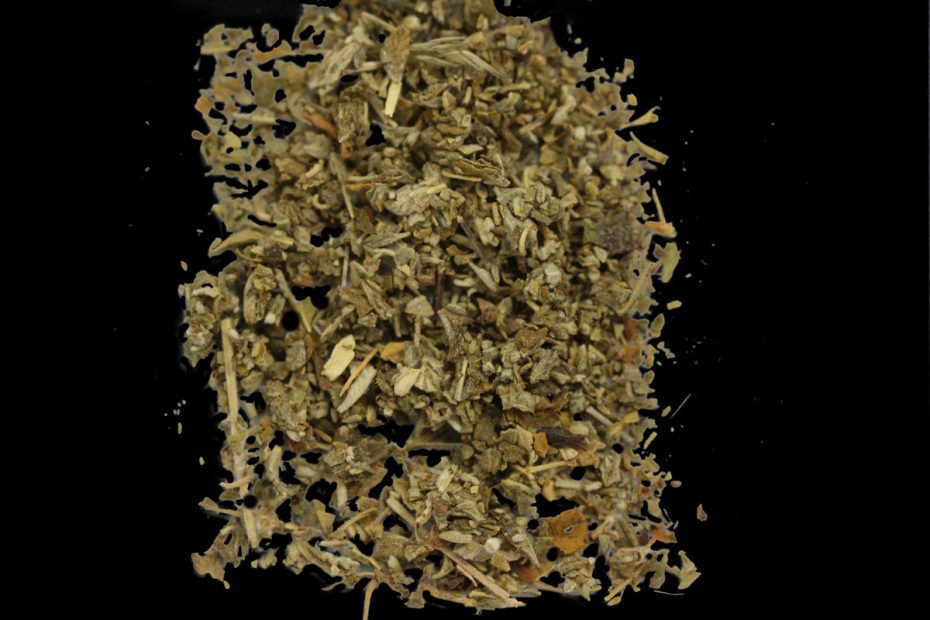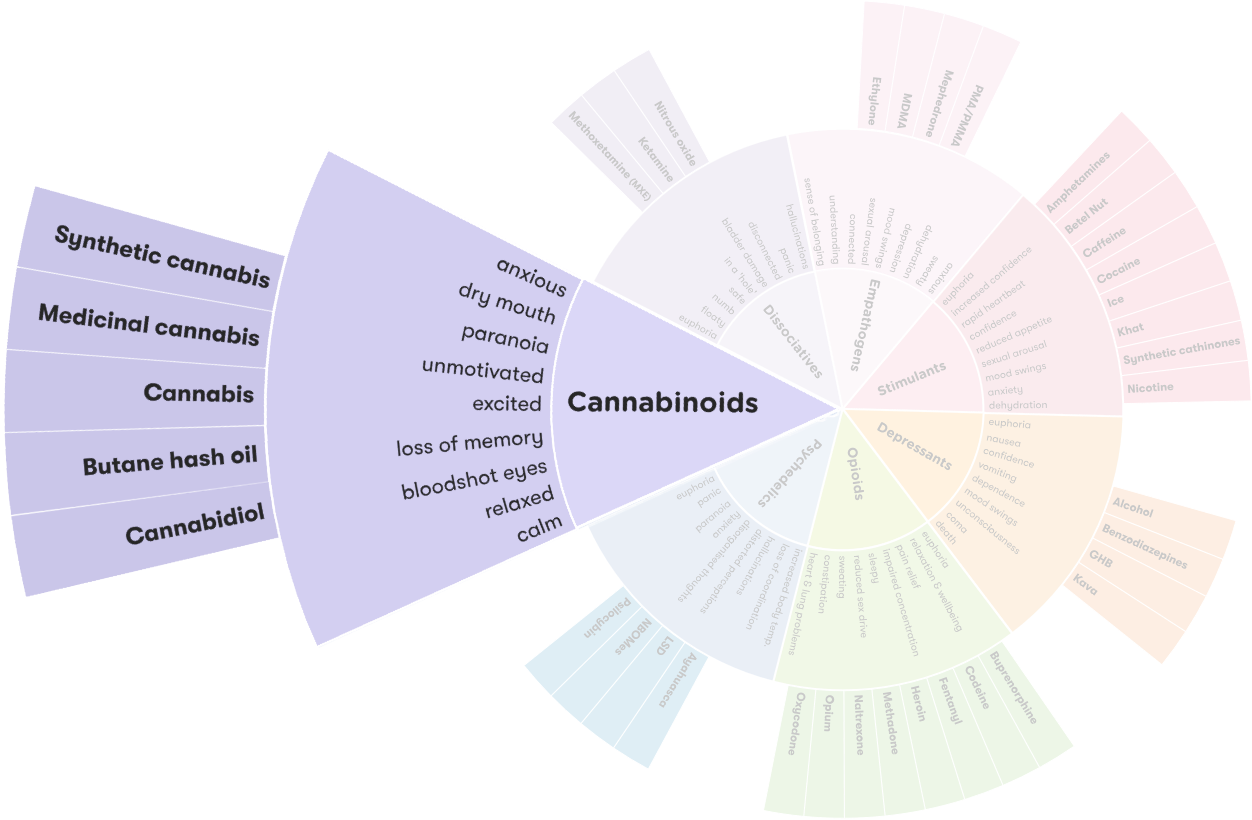How are synthetic cannabinoids used?
Synthetic cannabinoids are most commonly smoked.2 The effects are usually felt within minutes.5
Effects of synthetic cannabinoids
Use of any drug can have risks. It’s important to be careful when taking any type of drug.
Synthetic cannabinoids affect everyone differently, based on:
- size, weight and health
- whether the person is used to taking it
- whether other drugs are taken around the same time
- the amount taken
- the strength of the drug (varies from batch to batch)
- environment (where the drug is taken).
The effects of synthetic cannabinoids can include:
- relaxation
- euphoria
- loss of coordination
- fast and irregular heartbeat
- racing thoughts
- agitation, anxiety and paranoia
- psychosis
- aggressive and violent behaviour
- chest pain
- vomiting
- raised blood pressure (hypertension)
- breathing difficulties
- hyperthermia (overheating)
- breakdown of muscle tissue (rhabdomyolysis)
- acute kidney injury
- seizures
- stroke
- death.1, 6, 7
Set and Setting
Synthetic cannabinoids have varied effects depending on a person’s mood (often called the ‘set’) or the environment they are in (the ‘setting’):
- Set: a person’s state of mind, previous encounters with psychoactive drugs, and expectations of what’s going to happen.9 For example, feelings of stress or anxiety before using synthetic cannabinoids can be magnified and result in an unpleasant experience.
- Setting: the environment in which someone consumes synthetic cannabinoids – whether it’s known and familiar, who they’re with, if they’re indoors or outdoors, the type of music and light.9 For example, using synthetic cannabinoids in a calm, quiet and relaxed environment can lead to a pleasant experience but being in a noisy, crowded place may result in a negative experience.
Overdose
If you take a large amount, or have a strong batch, you could overdose. Call an ambulance straight away by dialling triple zero (000) if you have any of the following symptoms (Emergency services are there to help and can provide instructions over the phone):
- fast/irregular heart rate
- chest pain
- breathing difficulties
- severe hyperthermia (high body temperature)
- delusional behaviour. 1, 6, 7
Long-term effects
Regular use of synthetic cannabinoids can eventually cause mental health conditions, heart problems, and behavioural and cognitive impairments.8, 9Synthetic cannabinoids and mental health
People with mental health conditions or a family history of these conditions should avoid using synthetic cannabinoids.
People who use synthetic cannabinoids have a higher risk of experiencing symptoms of anxiety and depression, and long-term use is strongly linked to serious mental health conditions.7, 10, 11
Both healthy and vulnerable individuals can experience psychosis after using synthetic cannabinoids.7, 12-14 And, compared to cannabis, the psychotic symptoms associated with synthetic cannabinoids are more severe and can last for weeks following last use.7, 14, 15
Tolerance and dependence
People who regularly use synthetic cannabinoids can quickly become dependent on the drug. They may feel they need synthetic cannabinoids to go about their normal activities like working, studying and socialising, or just to get through the day. They may also develop a tolerance to it, which means they need to take larger amounts of synthetic cannabinoids to get the same effect.
Mixing synthetic cannabinoids with other drugs
The effects of taking synthetic cannabinoids with other drugs − including over-the-counter or prescribed medications − can be unpredictable and dangerous.
- Synthetic cannabinoids + antidepressants: mixing with antidepressant drugs such as SSRIs (selective serotonin reuptake inhibitors) is dangerous and can lead to fever, fast heartbeat, convulsions, organ failure, coma and death.16
- Synthetic cannabinoids + stimulants such as crystal methamphetamine (ice) or cocaine: effects can be particularly dangerous and increase likelihood of experiencing anxiety.
Use of more than one drug or type of drug consumed at the same time is called polydrug use.17
More on Polydrug use
Polydrug use is a term for the use of more than one drug or type of drug at the same time or one after another. Polydrug use can involve both illicit drugs and legal substances, such as alcohol and medications.
Giving up synthetic cannabinoids after using them for a long time is challenging because the body has to get used to functioning without them.
It has been reported that some people who use synthetic cannabinoids heavily, on a regular basis, may experience withdrawal symptoms when they try to stop, including:
- insomnia
- nausea and vomiting
- loss of appetite
- paranoia
- panic attacks
- agitation and irritability
- anxiety
- mood swings
- rapid heartbeat.19, 20
The risk of tolerance and dependence on synthetic cannabinoids and their associated effects may be reduced by taking regular breaks from smoking the drug and avoiding using a large amount at once.
Health and safety
There is no safe way to use synthetic cannabinoids. If you do decide to use the drug, it’s important to consider the following:
Regulating intake
- It is difficult to predict the strength and effects of synthetic cannabinoids (even if it has been taken before) as its strength varies from batch to batch.
- Trying a very small dose first can help gauge the strength and possible effects. Dose size should only be increased slowly – time should be given for the previous dose to wear off.
- Taking synthetic cannabinoids on their own without a ‘mixer’ such as tobacco or dried parsley should always be avoided. Similarly, inhaling the drug via bongs or pipes can increase the risk of an overdose or bad reaction.
Misleading packaging
- The packaging of synthetic cannabinoids can be misleading. Although contents may be described as ‘herbal’, the actual psychoactive material is synthetic.
- Not all ingredients or their correct amounts might be listed, which can increase the risk of overdose.
- Chemicals usually vary from batch to batch, so different packets can produce different effects, even if the packaging looks the same.
When it absolutely shouldn’t be used
Use of synthetic cannabinoids is likely to be more dangerous when:
- taken in combination with alcohol or other drugs, particularly stimulants such as crystal methamphetamine (‘ice’) or MDMA
- driving or operating heavy machinery
- judgment or motor coordination is required
- alone (in case medical assistance is required)
- the person has a mental health problem
- the person has an existing heart problem.
Getting help
If your use of synthetic cannabinoids is affecting your health, family, relationships, work, school, financial or other life situations, or you’re concerned about someone else, you can find help and support.
Call the National Alcohol and Other Drug Hotline on 1800 250 015 for free and confidential advice, information and counselling about alcohol and other drugs
Help and Support Services search
Find a service in your local area from our list. Simply add your location or postcode and filter by service type to quickly discover help near you.
If you're looking for other information or support options, send us an email at druginfo@adf.org.au
Path2Help
Not sure what you are looking for?
Try our intuitive Path2Help tool and be matched with support information and services tailored to you.

National
- 2.6% of Australians aged 14 years and over have used synthetic cannabinoids.21
- People who had used synthetic cannabinoids in their lifetime doubled between 2013 and 2019 (from 1.3% to 2.6%) – although recent use of the drug dropped from 1.2% to 0.2%.21
- In 2017, 2% of young people aged 12-17 years had used synthetic cannabinoids in the last 12 months.2
Synthetic cannabinoids are not legal in Australia – despite attempts to sell and market them as ‘legal’ alternatives to cannabis.23
In fact, states/territories have continued to change their laws to ensure these products remain illegal.
In 2021 the current laws are:
- In Queensland, New South Wales, South Australia and Victoria there’s a ‘blanket ban’ on possessing or selling any substance with a psychoactive effect, other than alcohol, tobacco and food.
- In Western Australia, specific NPS substances are banned, and new ones are regularly added to the banned list. This means a drug that was legal to sell or possess today, may be illegal tomorrow.
Commonwealth laws also ban any other psychoactive drug that isn’t already banned by existing laws in states and territories.4, 24
See also, drugs and the law.
- Dwyer J, Jamieson A. Coronial investigation into the death of Mr P - Annexure 1: Victorian deaths involving the synthetic cannabinoid Cumyl-PeGACLONE. Southbank: Coroners Court of Victoria; 2020.
- Darke S, Banister S, Farrell M, Duflou J, Lappin J. ‘Synthetic cannabis’: A dangerous misnomer. International Journal of Drug Policy [Internet]. 2021 [20.10.2021]; 98:[103396 p.].
- Bright S. Not for human consumption: new and emerging drugs in Australia. What do clinicians, allied health and youth workers, researchers and policy makers need to know? Melbourne: Alcohol and Drug Foundation; 2013.
- National Drug & Alcohol Research Centre (NDARC). New (and emerging) Psychoactive Substances (NPS): NDARC fact sheet. Sydney: UNSW; 2016.
- United Nations Office on Drugs and Crime. Synthetic Cannabinoids in herbal products. United Nations.
- Darke S, Duflou J, Farrell M, Peacock A, Lappin J. Characteristics and circumstances of synthetic cannabinoid-related death. Clinical Toxicology [Internet]. 2020 [18.10.2021]; 58(5):[368-74 pp.].
- Cohen K, Weinstein AM. Synthetic and Non-synthetic Cannabinoid Drugs and Their Adverse Effects-A Review From Public Health Perspective.Frontiers in public health [Internet]. 2018 [18.10.2021]; 6:[162- pp.].
- Altintas M, Inanc L, Oruc GA, Arpacioglu S, Gulec H. Clinical characteristics of synthetic cannabinoid-induced psychosis in relation to schizophrenia: a single-center cross-sectional analysis of concurrently hospitalized patients. Neuropsychiatric disease and treatment [Internet]. 2016 [21.10.2021]; 12:[1893-900 pp.].
- McIlroy G, Ford L, Khan JM. Acute myocardial infarction, associated with the use of a synthetic adamantyl-cannabinoid: a case report. BMC Pharmacology and Toxicology [Internet]. 2016 [21.10.2021]; 17(1):[2 p.].
- Cohen K, Mama Y, Rosca P, Pinhasov A, Weinstein A. Chronic Use of Synthetic Cannabinoids Is Associated With Impairment in Working Memory and Mental Flexibility. Frontiers in Psychiatry [Internet]. 2020 [22.10.2021]; 11(602).
- Vallersnes OM. Psychosis associated with acute recreational drug toxicity: a European case series. BMC Psychiatry [Internet]. 2016 [21.10.2021]; 16(1):[1 p.].
- Weinstein AM, Rosca P, Fattore L, London ED. Synthetic Cathinone and Cannabinoid Designer Drugs Pose a Major Risk for Public Health. Frontiers in Psychiatry [Internet]. 2017 [21.10.2021]; 8(156). Available from:
- Davidson C, Opacka-Juffry J, Arevalo-Martin A, Garcia-Ovejero D, Molina-Holgado E, Molina-Holgado F. Chapter Four - Spicing Up Pharmacology: A Review of Synthetic Cannabinoids From Structure to Adverse Events. 2017. In: Advances in Pharmacology [Internet]. Academic Press; [135-68]. Available from:
- Khan M. Catatonia secondary to synthetic cannabinoid use in two patients with no previous psychosis. American Journal on Addictions, The [Internet]. 2016 [22.10.2021]; 25(1):[25 p.].
- Castaneto MS, Gorelick DA, Desrosiers NA, Hartman RL, Pirard S, Huestis MA. Synthetic cannabinoids: Epidemiology, pharmacodynamics, and clinical implications.Drug and Alcohol Dependence [Internet]. 2014 [22.10.2021]; 144:[12-41 pp.].
- Talk to Frank. Synthetic cannabinoids: FRANK [03.12.2021].
- Darke S, Lappin, J. & Farrell, M. The Clinician's Guide to Illicit Drugs. United Kingdom: Silverback Publishing 2019.
- World Health Organisation. Lexicon of Alcohol and Drug Terms. World Health Organisation; 1994.
- Macfarlane V, Christie G. Synthetic cannabinoid withdrawal: a new demand on detoxification services. Drug and alcohol review. 2015;34(2):147-53.
- Zawilska JB, Wojcieszak J. Spice/K2 drugs–more than innocent substitutes for marijuana. International Journal of Neuropsychopharmacology. 2014;17(3):509-25.
- Australian Institute of Health and Welfare. National Drug Strategy Household Survey 2019. Canberra: AIHW; 2020.
- Guerin N, White V. ASSAD 2017 Statistics & Trends: Australian Secondary Students’ Use of Tobacco, Alcohol, Over-the-counter Drugs, and Illicit Substances. Centre for Behavioural Research in Cancer: Cancer Council Victoria; 2020.
- Positive Choices. Synthetic Cannabinoids: Factsheet 2021 [19.10.2021].
- Australian Institute of Health and Welfare. Alcohol, tobacco & other drugs in Australia 2021 [updated 22 July 2021. Available from:

